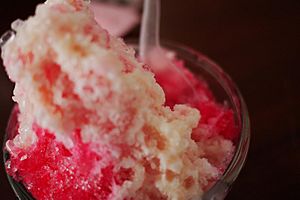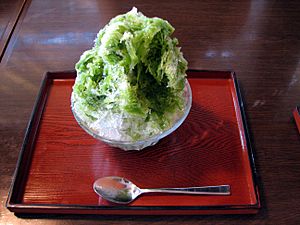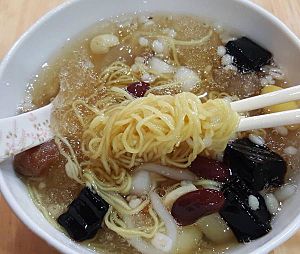Namkhaeng sai facts for kids
 |
|
| Alternative names | Wan yen |
|---|---|
| Type | Shaved ice or snow cone |
| Place of origin | Thailand |
Namkhaeng sai (Thai: น้ำแข็งไส) is a super cool Thai dessert. It's a lot like shaved ice or a snow cone. People also call it wan yen (หวานเย็น).
What makes Namkhaeng sai special is that its yummy toppings are usually placed at the bottom of the bowl. There are so many different toppings to choose from, sometimes 20 to 30 kinds! Some popular ones include young coconut soaked in coconut milk, black sticky rice, chestnuts, sweet taro, and red beans.
Contents
The Story of Namkhaeng Sai
Ice Arrives in Thailand
A long time ago, during the reign of King Rama IV of Siam, ice was a very rare and special thing. It wasn't made in Thailand yet!
Ice had to be brought all the way from Singapore. It traveled by steamboat, packed carefully inside a wooden box. A person named Chao Phraya Pisont Sombut Boriboon was the one who ordered this exotic ice.
Thailand's First Ice Factory
In 1905, the very first ice factory in Thailand opened its doors. It was founded by Phraya Bhakdi Noraset (also known as Lert Sreshthaputra). The factory was called "Siam Ice Factory," but many people just called it "Nai Lert Ice Factory."
Once ice became easier to get, people started using it in desserts. This led to the creation of "Kanom Namkhaeng Sai," which means "desserts with shaved ice."
How Namkhaeng Sai Changed Over Time
The first simple Namkhaeng sai came from Chinese people in Phetchaburi province. It was just shaved ice with a sweet red syrup and a type of fried dough called Patongo.
Later, around 1947, condensed milk became very popular. People started pouring it on top of their Namkhaeng sai. This version was often called "Chum Ba."
Today, Namkhaeng sai has many more exciting ingredients. You can find it with bread, cheesecake, or even brownies! Instead of just red syrup, people use juice, tea, coffee, or chocolate. It's often topped with fresh fruits, candies, jelly, and cereals. You can find this delicious dessert everywhere, from big shopping malls to local street stalls. It's still a favorite way to cool down in Thailand!
What's in Namkhaeng Sai?
Namkhaeng sai doesn't have one strict recipe. It really depends on what you like! Here are some common ingredients people use:
| Sauces | Toppings |
|---|---|
|
|
How to Make Namkhaeng Sai
Making Namkhaeng sai is super easy! 1. First, you need to shave the ice. You can do this by hand or use a special shaved ice machine. 2. Next, cut your favorite toppings into small, bite-sized pieces. 3. Finally, pour your chosen sauce over the ice and toppings. Enjoy your delicious Namkhaeng sai!
Other Cool Desserts
Similar Thai Desserts
There are other Thai desserts that also use ice as a main ingredient. They are like cousins to Namkhaeng sai! Here are a few examples:
- Fruity granitas
- Tubtim Krob
- Salim
- Lod Chong
- Som Chun
- Mee Yen
- Mun Duey Tua
- O-Aew-Aiyu Jelly
Shaved Ice Around the World
Many other countries have their own versions of shaved ice desserts, similar to Namkhaeng sai!
- Japan: Kakigori
Kakigori is Japanese shaved ice. It can be simple, with just fruit syrup, or fancy, with condensed milk, red beans, and chewy Dango Mochi.
- Taiwan: Tshuah-Ping
Tshuah-Ping (also called Tsua Bing or Baobing) is Taiwanese shaved ice. It's known for its juicy toppings like sugar water, condensed milk, or fresh seasonal fruits. There's also a special kind called Xuehua Bing, where the shaved ice is made from frozen milk!
- South Korea: Bingsu
Bingsu (or Bingsoo) is a popular Korean shaved ice dessert. The main difference from Kakigori is that Bingsu uses milk to make its fluffy shaved ice, while Kakigori uses water. Bingsu often has chunky toppings like popping boba or chopped fruit.
- Philippines: Halo-Halo
Halo-Halo means "Mix-Mix" in English. It's the most famous Filipino shaved ice. It's usually served in a tall, clear glass so you can see all the colorful layers and textures!
- India: Ice Gola
Ice Gola is a simple Indian shaved ice that's easy to eat on the go. It's just shaved ice covered with sweet syrup, served on a stick, much like a snow cone in the United States. It has many names, like Gola, Baraf Gola, or Chuski.
- Indonesia: Es Campur
Es Campur means "Mixed Ice" in English. It's an Indonesian shaved ice dessert that's similar to Bingsu or Halo-Halo because it has lots of different toppings.
- Turkey: Bici Bici
Bici Bici is a Turkish shaved ice. It uses starch mixed with water as a base for the shaved ice, and rose water for flavor. Sugar is sprinkled on top.
Images for kids





